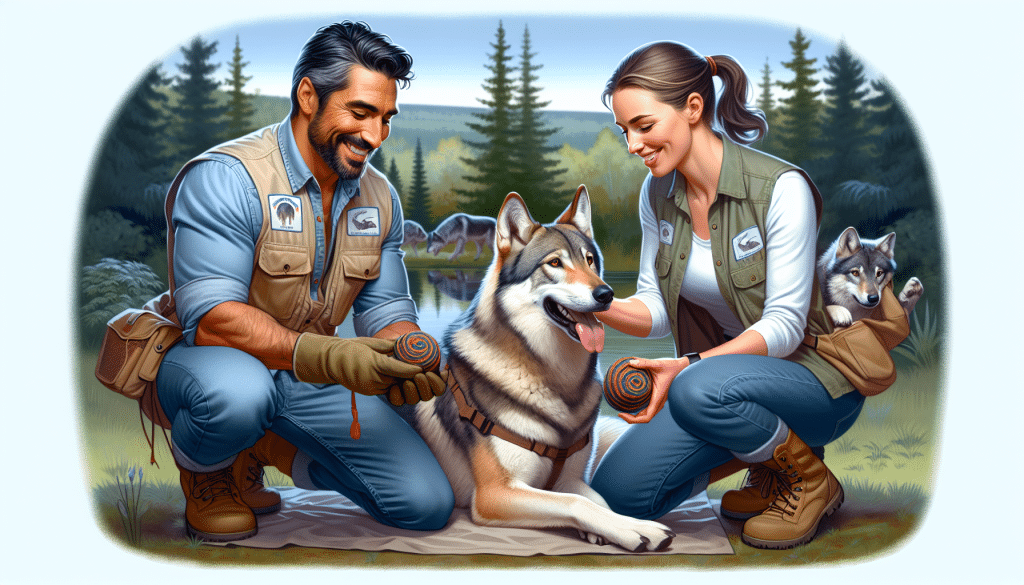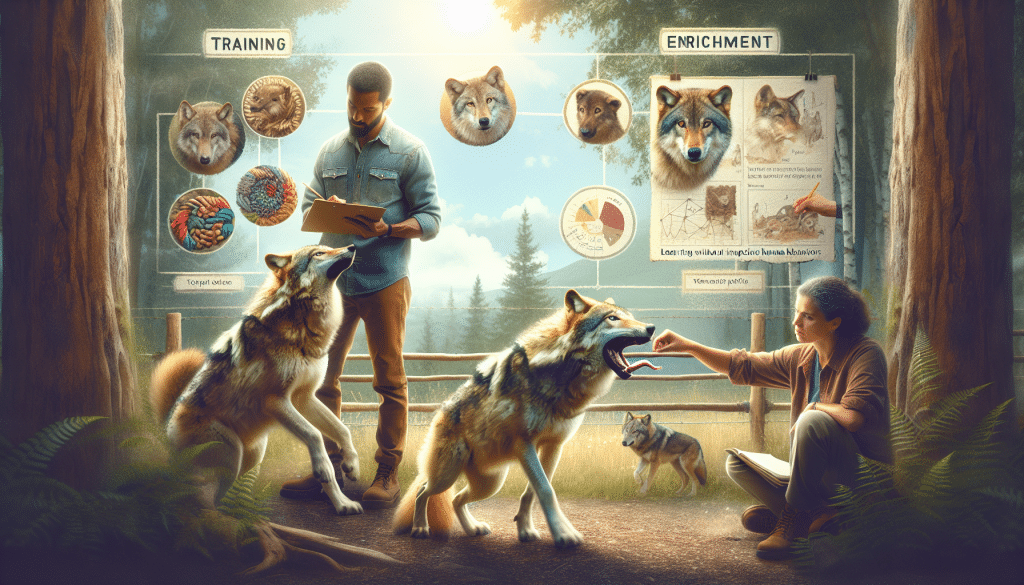Have you ever wondered what it takes to train and enrich the lives of wolves? In this article, you will discover the fascinating world of wolf training and enrichment techniques. From learning how to communicate with these majestic creatures to providing them with stimulating activities, you will gain insight into the art of wolf training and see how it helps them thrive in their natural habitats. So, get ready to embark on a journey into the remarkable world of these captivating creatures and the strategies used to enhance their lives!

Understanding Wolf Behavior
Wolves are fascinating creatures with unique behaviors that help them survive and thrive in their natural habitats. Understanding their behaviors is key to developing effective training and enrichment strategies.
Pack Dynamics and Hierarchy
Wolves are highly social animals that live in packs, which are structured social units. Each pack has a dominant alpha pair, typically a male and female, that leads the group. Under the alpha pair, there may be subordinate wolves, referred to as beta wolves. This hierarchical structure helps maintain order and cooperation within the pack.
Communication Methods
Wolves communicate with each other through a variety of methods. They use vocalizations such as howling, growling, and barking to convey messages and coordinate activities. Additionally, they utilize body language, such as facial expressions, ear and tail positioning, and posture, to convey dominance, submission, aggression, or playfulness. Understanding these communication methods is crucial for effective training and communication with wolves.
Natural Instincts and Drives
Wolves have powerful natural instincts and drives that are deeply ingrained in their genetic makeup. These instincts include hunting, territoriality, and pack bonding. Training and enrichment activities should take these instincts into consideration, providing opportunities for wolves to express and channel their natural drives in a safe and appropriate manner.
The Role of Conditioning in Wolf Behavior
Conditioning plays a significant role in shaping wolf behavior. Through positive reinforcement, wolves can be trained to associate certain behaviors with rewards, such as treats or praise. This helps to establish desired behaviors and modify unwanted ones. It is important to note that conditioning should always be done in a humane and ethical manner, with a focus on building trust and maintaining the wolf’s well-being.
The Ethics of Wolf Training
When it comes to training wolves, ethical considerations are of utmost importance. The following aspects should be carefully evaluated and prioritized:
Conservation vs. Domestication
One of the primary ethical concerns in wolf training is striking a balance between conservation efforts and domestication. Wolves are wild animals that play a crucial role in ecosystems. Training and captivity should prioritize conservation, ensuring that wolves can still exhibit their natural behaviors and contribute to their species’ well-being.
Welfare Considerations in Captivity
Welfare considerations are paramount when training wolves in captivity. The physical and psychological well-being of the wolves should always be prioritized, providing them with a suitable environment, proper nutrition, and opportunities to express their natural instincts. Any training methods or practices that cause harm or distress to the animals should be avoided.
Legal Implications
Training and keeping wolves may be subject to legal regulations and licensing requirements, depending on the jurisdiction. It is essential to ensure that all legal obligations are met to guarantee the ethical and responsible management of wolves in training programs or captive settings.
The Impact on Wild Wolf Populations
Training and captivity can have potential implications for wild wolf populations. Care must be taken to prevent any negative impacts, such as accidental release of captive wolves into the wild or detrimental effects on the genetic diversity of wild populations. Responsible management strategies should be implemented to minimize any potential harm.

Foundational Training Techniques
Foundational training techniques are crucial for building a strong training relationship between wolves and trainers. These techniques focus on positive reinforcement and establishing boundaries.
Positive Reinforcement Methods
Positive reinforcement is a highly effective and ethical training method for wolves. By rewarding desired behaviors with treats, toys, or praise, trainers can reinforce these behaviors and encourage wolves to repeat them. This type of training creates a positive association and builds trust between the wolf and the trainer.
Boundary and Limit Setting
Establishing clear boundaries and limits is essential for both the safety of the wolves and the trainers. Through consistent and fair rules, wolves learn what behaviors are acceptable and what are not. Effective communication and reinforcement of these boundaries help create a harmonious training environment.
Socialization with Humans and Other Wolves
Proper socialization with humans and other wolves is crucial for wolves to develop positive relationships and adapt to different social situations. Early and ongoing socialization allows wolves to feel comfortable and confident in a variety of settings and can help prevent behavioral issues.
Clicker Training Adaptations for Wolves
Clicker training, a method that uses a clicking sound to mark desired behavior, can also be adapted for wolves. By associating the clicker sound with a reward, trainers can effectively communicate and reinforce specific behaviors. Clicker training can be a valuable tool for shaping complex behaviors and fostering mental stimulation in wolves.
Creating a Structured Environment
Creating a structured environment is essential for the well-being and development of wolves. A structured environment provides a predictable routine and safe spaces for exploration.
Habitat Design and Safety
When designing a wolf habitat, it is crucial to consider the natural needs and instincts of the wolves. The habitat should provide adequate space for exercise and exploration while ensuring safety and security. Natural elements such as trees, rocks, and water features can be incorporated to mimic the wolves’ natural surroundings.
Routine and Schedule
Wolves thrive in predictable routines, as it helps establish a sense of security and stability. Establishing a consistent feeding schedule, training sessions, and enrichment activities can greatly benefit the wolves, providing mental stimulation and a structured daily routine.
Providing Adequate Space for Exploration
Wolves are highly active and inquisitive animals that require ample space for exploration. Providing a large and diverse habitat allows them to exhibit natural behaviors, such as scent marking, digging, and running. Enriching the environment with objects and structures for climbing and hiding can further stimulate their curiosity and provide opportunities for physical exercise.
Incorporating Natural Elements
Incorporating natural elements in the wolf habitat not only enhances their well-being but also provides opportunities for mental stimulation. The presence of trees, plants, and natural materials allows wolves to engage in scent marking, foraging, and other natural behaviors. It is important to ensure that these elements are safe and non-toxic for the wolves.

Behavioral Enrichment Strategies
Behavioral enrichment is crucial for the mental and physical well-being of wolves. It provides opportunities for them to engage in natural behaviors, experience sensory stimulation, and promote overall psychological health.
Puzzle Toys and Problem-Solving Activities
Puzzle toys and problem-solving activities provide mental stimulation for wolves. These toys can be filled with food or treats, requiring wolves to use their problem-solving skills to access the rewards. This type of enrichment promotes mental agility and helps prevent boredom in captive wolves.
Sensory Enrichment: Scent, Sound, and Sight
Sensory enrichment aims to replicate different stimuli that wolves would encounter in their natural habitats. This can be achieved through the use of scents, such as herbs or animal scents, and by playing natural sounds, such as bird chirping or running water. Visual enrichment can be provided by installing windows or screens that allow wolves to observe their surroundings.
Physical Enrichment: Exercise and Play
Physical enrichment is crucial for maintaining the physical health of wolves. Providing access to large spaces for running, climbing structures, and toys that encourage active play helps fulfill their natural need for exercise and promotes overall fitness.
Social Enrichment: Interaction with Other Wolves
Social enrichment involves providing opportunities for wolves to interact with other members of their species. This interaction can promote social bonds, communication skills, and the expression of natural behaviors. Care must be taken when introducing wolves to prevent aggression and ensure the safety of all individuals involved.
Nutritional Enrichment
Nutritional enrichment focuses on providing wolves with a varied and stimulating diet. It aims to replicate the natural prey that wolves would consume in the wild and promote mental stimulation during feeding.
Replicating Natural Prey in Diet
To provide nutritional enrichment, the diet of captive wolves should closely resemble the diet of their wild counterparts. This includes a combination of meat, bones, and organs. Introducing whole prey items, such as rabbits or fish, can provide a more natural feeding experience for the wolves.
Feeding Techniques to Promote Mental Stimulation
Feeding techniques can be used to promote mental stimulation during mealtime. For example, hiding food in puzzle toys or scatter feeding in the habitat encourages wolves to forage and use their problem-solving skills to find their food. These techniques keep the wolves mentally engaged and prevent them from becoming bored with their meals.
The Role of Diet in Behavioral Health
Proper nutrition plays a significant role in maintaining the overall behavioral health of wolves. A balanced and nutritious diet helps ensure optimal physical condition, which in turn can have a positive impact on their behavior and well-being. Consulting with veterinarians and nutritionists specializing in wolf diets can help provide the best dietary options for captive wolves.
Vitamin and Mineral Supplements for Captive Wolves
In some cases, captive wolves may require vitamin and mineral supplements to maintain their health. These supplements should be provided under the guidance of veterinarians, who can assess the specific needs of the individual wolves and recommend appropriate additions to their diet. Regular monitoring of the wolves’ health is crucial to ensure they receive the necessary nutrients.
Healthcare and Maintenance
Proper healthcare and maintenance are essential for the overall well-being of captive wolves. Regular veterinary care, vaccinations, parasite control, and grooming help maintain their physical health and prevent the onset of health issues.
Regular Veterinary Check-Ups
Regular veterinary check-ups are crucial to monitor the health of captive wolves. Routine examinations allow veterinarians to assess their overall well-being, provide necessary vaccinations, and identify any potential health issues early on. These check-ups should be performed by professionals experienced in wolf care.
Vaccinations and Preventative Medicine
Vaccinations help protect captive wolves from various diseases and minimize the risk of outbreaks within the population. Additionally, regular administration of preventative medicines, such as flea and tick control, helps maintain the wolves’ overall health and comfort.
Parasite Control
Parasite control is essential to prevent the infestation of external and internal parasites in wolves. Regular deworming and flea and tick prevention measures should be implemented to keep the wolves healthy and free from discomfort caused by parasites. Veterinarians can provide guidance on the best parasite control options for captive wolves.
Grooming and Hygiene
Regular grooming and hygiene practices are necessary to keep wolves clean and comfortable. This includes brushing their fur to remove tangles, cleaning their ears and teeth, and trimming their nails when necessary. Wolves should be handled with care during grooming to avoid stress or injury.
Advanced Training Challenges
Once foundational training has been established, advanced training challenges can be introduced to further develop the abilities and skills of the wolves.
Agility and Obedience Training
Agility and obedience training can help enhance a wolf’s physical coordination, mental focus, and responsiveness to commands. These training techniques involve teaching wolves to navigate through obstacles, follow commands, and perform complex tasks. Agility and obedience training should always be conducted under the guidance of experienced trainers.
Off-Leash Control and Recall Training
Off-leash control and recall training are advanced skills that provide wolves with freedom while maintaining control over their behavior. These techniques involve training wolves to respond reliably to recall commands and stay focused on their handler without the need for physical restraints. Off-leash control should only be attempted in safe and controlled environments.
Desensitization and Counterconditioning
Desensitization and counterconditioning are techniques used to reduce fear or anxiety in response to specific stimuli. By gradually exposing wolves to potentially stressful situations and pairing them with positive experiences or rewards, their fear or anxiety can be diminished. These techniques are particularly useful for helping wolves overcome phobias or aversions.
Cognitive Games and Intelligence Tests
Cognitive games and intelligence tests provide mental stimulation and challenge wolves’ problem-solving abilities. These games involve tasks that require wolves to use their cognitive skills and make decisions to earn rewards. Examples of cognitive games include hiding treats and challenging puzzles.
Integrating Wolves with Other Animals
Integrating wolves with other animals can be a complex process that requires careful planning and monitoring. Considerations must be made to assess compatibility, establish introduction protocols, monitor interactions, and ensure long-term coexistence.
Assessing Compatibility
Compatibility between wolves and other animals should be assessed based on factors such as species characteristics, social dynamics, and individual behavior. Wolves may have natural prey drive that can pose a threat to smaller animals. Assessing compatibility helps prevent conflicts or harm to any animals involved.
Introduction Protocols
Introducing wolves to other animals should be done gradually and under controlled circumstances. Proper introduction protocols, such as supervised meetings in neutral spaces, allow animals to acclimate to each other’s presence and establish positive associations. The speed and progression of introductions should be tailored to the individuals involved.
Monitoring Interactions
Continuous monitoring of interactions between wolves and other animals is crucial to identify any signs of aggression, fear, or stress. Close observation allows for timely intervention if any conflicts or negative behaviors arise. Monitoring interactions ensures the safety and well-being of all animals involved.
Long-Term Coexistence
Long-term coexistence between wolves and other animals requires ongoing monitoring, management, and adjustment of the living arrangements. Relationships and dynamics may change over time, necessitating periodic assessments to ensure the continued safety and welfare of all animals in the shared environment.
Case Studies in Wolf Training and Enrichment
Case studies provide valuable insights into successful training and enrichment programs for wolves. Learning from these experiences can help refine best practices in captive wolf management.
Success Stories from Sanctuaries and Reserves
Sanctuaries and reserves play a crucial role in rehabilitating and providing lifelong care for wolves. Success stories showcase the positive outcomes achieved through effective training and enrichment programs. These stories highlight the dedication, expertise, and commitment required to create a fulfilling and enriching environment for captive wolves.
Training Programs in Zoological Parks
Zoological parks often have training programs aimed at promoting the welfare and well-being of their animals, including wolves. These programs emphasize positive reinforcement, enrichment, and cognitive stimulation to enhance the wolves’ health and behavior. Through case studies of successful training programs, valuable lessons can be learned and applied to other captive wolf environments.
Rehabilitation of Injured or Rescued Wolves
Injured or rescued wolves often require specialized training and enrichment to aid in their rehabilitation. These cases involve not only physical healing but also addressing any behavioral issues caused by prior trauma. Case studies in the rehabilitation of injured or rescued wolves provide insights into the challenges and successes associated with helping these animals recover and adjust to new environments.
Comparisons of Captive vs. Wild Behavior
Comparing captive wolf behavior to that of their wild counterparts offers valuable insights into the impacts of training and captivity. Observations of both populations shed light on the adaptations, behaviors, and mental well-being of wolves in different contexts. Understanding the similarities and differences between captive and wild behavior helps inform the development of training and enrichment strategies.
In conclusion, understanding and effectively training wolves require a comprehensive knowledge of their behavior, ethical considerations, foundational techniques, environmental factors, enrichment strategies, health care, and advanced training challenges. By implementing responsible and thoughtful practices, trainers can create a positive and enriching environment for captive wolves, promoting their well-being and enhancing our understanding of these beautiful creatures.



